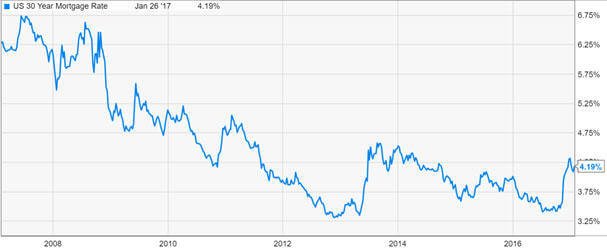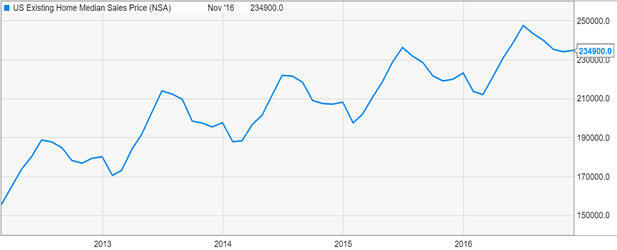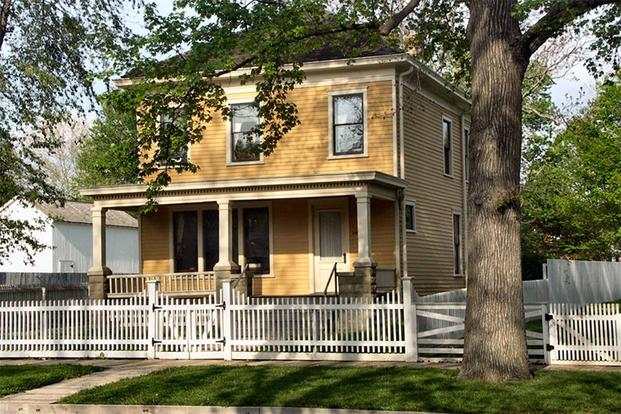If you follow the topic of mortgage interest rates, you will notice that all the hype lately is around how they’ve steadily been on the rise. On the surface, most would be home buyers would consider this a bad thing. This could be true if you just viewed an increase in rates in isolation and not factor many of the positive conditions that it creates. The effect of rising rates can be advantageous for someone looking to use their VA loan.
This article will walk you through a high level of how mortgage interest rates and home prices got to where they are, and provide a practical way to get started in using your VA Loan Benefits.
Why Mortgage Rates are Rising
Since 2008, rates have fallen to historic lows as shown below in Figure 1. This was largely caused by the “The Great Recession” when the world was on the brink of financial failure. In a nutshell: The US Government initiated an economic concept called Quantitative Easing which is adding more money into the existing money supply. The Federal Reserve “The Fed” did this by buying mortgage backed securities. Where did the money come from you might ask? The Fed printed it. Without making this an exhaustive article on the mechanics of monetary policy, the end result of printing more money caused mortgage interest rates to go down. With the end of the US Quantitative Easing, combined with a host of other factors such as an increase in the federal funds rate (the rate that banks borrow money at), is causing mortgage interest rates to rise.
Figure 1 (10 Year Mortgage Interest Rates)

Why Home Prices are Climbing
With “The Great Recession” foreclosures skyrocketed, combined with a large amount of speculative development, created excessive amount of homes in the market and not enough buyers. Compounding this was the fact that mortgage lending standards tightened making it harder for those to qualify for a mortgage. In a nutshell: With excess amount of homes in the market, and not enough qualified buyers, home values declined. Figure 2 below shows the average US Home Values over the past 10 years. Now, a lot of the excess homes have been bought and with less supply of homes for sale in the market. As a result, home values have been on the rise. In fact, in many places across the United States, buyers are having to compete against each other when making offers to purchase a home.
Figure 2

How do I know if it’s the right time for me to buy?
Interest rates normally fluctuate…Meaning that interest rates rise and fall. Even though the interest rates have been on a steady climb, they are still at historic lows as shown in Figure 1. In addition, as interest climb, in most cases this will have a cooling effect on the growth of home prices which could make it more affordable for the would be home buyer.
How Should You Proceed?
Markets have always fluctuated with interest rates and/or home appreciation. Becoming a homeowner is an awesome responsibility but ensuring that you are properly prepared is key. Below are the steps in using your VA loan to buy a home.
- Compare rates and fees between VA loan providers. They are not all the same and it is important that you select the lender that has experience with VA loans.
- Obtain your Certificate of Eligibility. Most lenders can assist you in doing this. Otherwise you can obtain it directly from the VA.
- Select a Real Estate Agent that knows how to work with VA loans. This is key as the VA loan has some processes that are different when compared to other loans such as the appraisal process. It’s important to work with an agent or company that is experienced in working with VA loan purchases.
- Find a home and place an offer. This is an exciting phase and a good real estate agent will craft the offer so that it has the greatest chance of being accepted. It is a competitive buying environment as we discussed, so it is even more important to have a compelling offer.
- Your offer is accepted. When your offer is accepted, it will cascade a number of things to ultimately close on your home:
- Underwriting-The Lender will go through all of your income and debts
- VA Appraisal-A VA representative will inspect the home to ensure it represents the value that you are paying and is in the required condition.
- Homeowners Insurance-Required by your lender to safeguard you in the event of hazards i.e. fire, hail, ext.
- Title Insurance-Insurance in the event that someone has claim to the home this insurance covers you for that.
- Closing. You’ll attend your closing and sign a heap of documents. Once this is complete, you will get your keys and are now a homeowner.
The MVP’s of your home buying team are a great VA loan lender and real estate agent. Buying a home can be daunting, especially if it’s your first time. By having a strong team, they will collectively shoulder a big portion of the work for you and advise you throughout your homebuying journey.
Grant Moon is an Army Reserve Major and CEO of VA Loan Captain, Inc., a veteran-owned business that facilitates VA Home Loan Purchase and Refinances through a platform of lenders that offer competitive rates for veterans and servicemembers. He is also the author of the "Ultimate Guide to VA Loans" from a Veteran's Perspective. For more information, visit www.valoancaptain.com.










